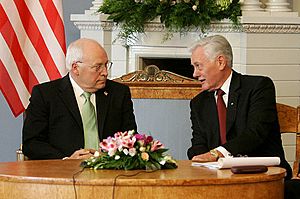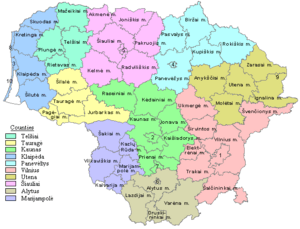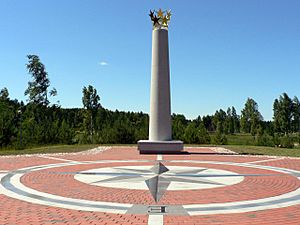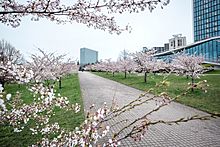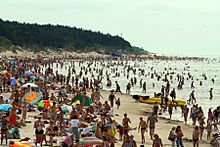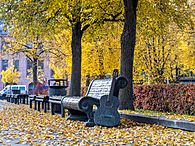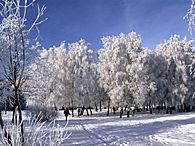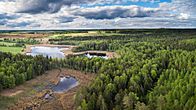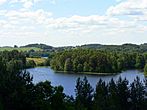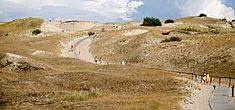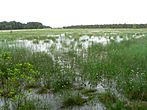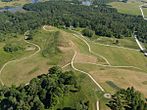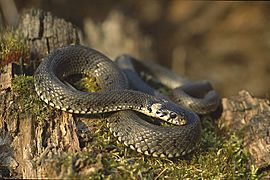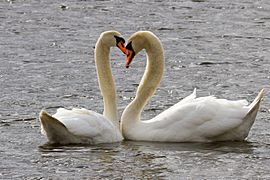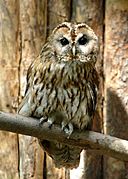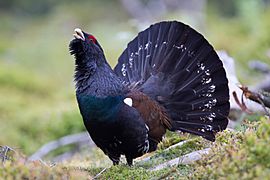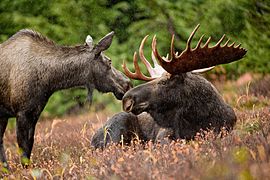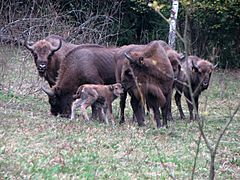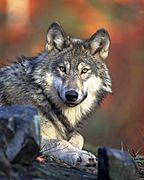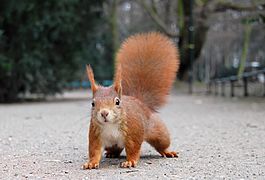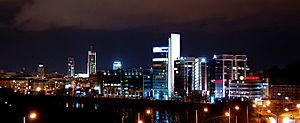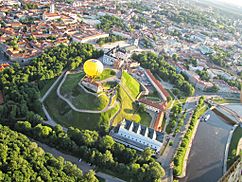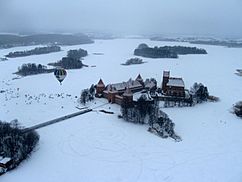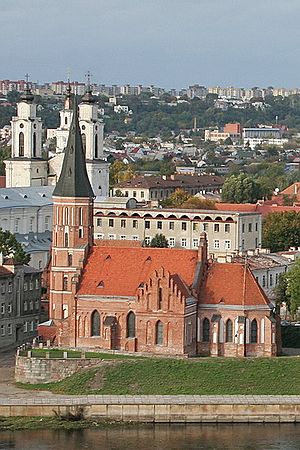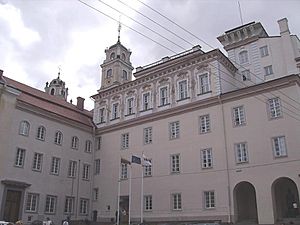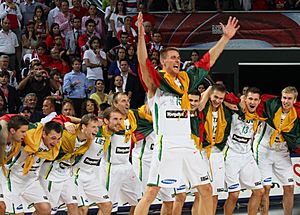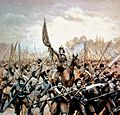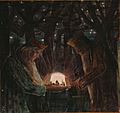Lithuania facts for kids
Quick facts for kids
Republic of Lithuania
Lietuvos Respublika (Lithuanian)
|
|
|---|---|
|
Anthem:
Tautiška giesmė "National Song" |
|
![Location of Lithuania (dark green)– on the European continent (green & dark grey)– in the European Union (green) — [Legend]](/images/thumb/e/ec/EU-Lithuania.svg/350px-EU-Lithuania.svg.png)
Location of Lithuania (dark green)
– on the European continent (green & dark grey) |
|
| Capital and largest city
|
Vilnius 54°41′N 25°19′E / 54.683°N 25.317°E |
| Official languages | Lithuanian |
| Ethnic groups
(2025)
|
|
| Religion
(2021)
|
|
| Demonym(s) | Lithuanian |
| Government | Unitary semi-presidential republic |
| Gitanas Nausėda | |
| Inga Ruginienė | |
| Juozas Olekas | |
| Legislature | Seimas |
| Formation | |
|
• First mentioned
|
9 March 1009 |
| 1236 | |
|
• Coronation of Mindaugas
|
6 July 1253 |
| 2 February 1386 | |
|
• Commonwealth created
|
1 July 1569 |
| 24 October 1795 | |
|
• Independence reinstated
|
16 February 1918 |
|
• Soviet occupation
|
16 June 1940 |
|
• Independence restored
|
11 March 1990 |
| Area | |
|
• Total
|
65,300 km2 (25,200 sq mi) (121st) |
|
• Water (%)
|
1.98 (2015) |
| Population | |
|
• 2025 estimate
|
|
|
• Density
|
44/km2 (114.0/sq mi) (138th) |
| GDP (PPP) | 2025 estimate |
|
• Total
|
|
|
• Per capita
|
|
| GDP (nominal) | 2025 estimate |
|
• Total
|
|
|
• Per capita
|
|
| Gini (2023) | ▼ 35.7 medium |
| HDI (2023) | very high · 39th |
| Currency | Euro (€) (EUR) |
| Time zone | UTC+2 (EET) |
|
• Summer (DST)
|
UTC+3 (EEST) |
| Date format | yyyy-mm-dd |
| Driving side | right |
| Calling code | +370 |
| ISO 3166 code | LT |
| Internet TLD | .lt |
Lithuania is a country in northern Europe. It is located on the eastern shore of the Baltic Sea. Lithuania is a member of the European Union and NATO.
About 3 million people live in Lithuania. The official language is Lithuanian. More than 82% of the people speak it. Vilnius is the capital city and also the largest city.
The Lithuanian flag has three colors. Yellow is at the top and stands for the sun. Green is in the middle and represents the fields. Red is at the bottom and symbolizes the blood of Lithuanians who fought for their freedom.
Contents
History of Lithuania
Lithuania started to become a country between the 7th and 9th centuries. The Baltic people, who are ancestors of Lithuanians and Latvians, settled in the area. This area is between the Nemunas and Daugava rivers and the Baltic Sea. Many scientists believe they arrived around 3000 BC.
The country officially began in 1236. This was when Lithuanians won the Battle of Šiauliai, also known as the Battle of Sun.
Lithuania, then called the Grand Duchy of Lithuania, made a treaty with Poland in 1569. The Russian Empire took over the country in 1795. Lithuania regained its independence on February 16, 1918.
However, it was taken over by the Soviet Union in 1940. Then Nazi Germany occupied it from 1941 to 1944. The Soviet Union took control again from 1944 to 1990. Lithuania finally declared its independence again on March 11, 1990. Today, Lithuania is an independent, democratic republic.
How Lithuania is Governed
Lithuania has been a member of NATO and the European Union since 2004. It is a semi-presidential republic. This means it has both a president and a prime minister.
Lithuania restored its independence and democracy in 1990. Since then, many important changes have been made. Lithuania is now a democratic state that protects human rights.
The country's main law is the Constitution, adopted in 1992. It says that the President is the leader of the country. The President is elected every 5 years. If the President breaks their promises, the Parliament can make them leave office. The President also represents Lithuania to other countries. They are also the commander-in-chief of the military.
The law-making part of Lithuania's government is called the Seimas, or Parliament. There are 141 members of the Seimas. They are elected for 4-year terms. The Seimas passes laws. The government, which is formed in the Seimas, carries out these laws. The President must approve the government. The President also chooses and removes the Prime Minister.
The courts handle justice in Lithuania. The highest court is the Constitutional Court.
Parts of Lithuania
Lithuania is divided into 10 main areas called counties. These counties are then split into 60 smaller areas called municipalities. Inside the municipalities, there are about 500 even smaller areas called elderates.
The 10 counties are:
- Alytus County
- Kaunas County
- Klaipėda County
- Marijampolė County
- Panevėžys County
- Šiauliai County
- Tauragė County
- Telšiai County
- Utena County
- Vilnius County
A governor leads each county. The central government chooses these governors. Municipalities are run by Municipal Councils. These councils are elected for 4-year terms. The head of a municipality is called the mayor. Elderates are run by elders. The municipal councils choose the elders.
Geography of Lithuania
Lithuania is in northern-eastern Europe. It covers an area of about 65,200 square kilometers. It has about 99 kilometers of sandy coastline. Only about 38 kilometers of this coastline faces the open Baltic Sea. The rest of the coast is protected by the Curonian sand peninsula.
Lithuania's main port, Klaipėda, is at the mouth of the Curonian Lagoon. This is a shallow lagoon that stretches south to Kaliningrad. The country's largest river, the Nemunas River, is used for international shipping. Some of its smaller rivers also allow shipping.
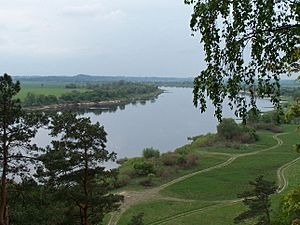
Lithuania is on the edge of the North European Plain. Its landscape was shaped by glaciers from the last ice age. It has a mix of lowlands and highlands. The highest point is Aukštojas Hill, which is 294 meters tall. This is in the eastern part of the country. The land has many lakes and wetlands. Forests cover over 33% of the country. Drūkšiai is the largest lake. Tauragnas is the deepest, and Asveja is the longest lake in Lithuania.
In 1989, scientists looked at the boundaries of Europe again. A French scientist, Jean-George Affholder, found that the geographic centre of Europe is in Lithuania. It is about 26 kilometers north of Vilnius, the capital city. He found this by calculating the center of gravity of Europe's shape.
Climate in Lithuania
Lithuania has a mild climate. It is a mix of maritime (near the sea) and continental (inland). On the coast, the average temperature is -2.5°C in January and 16°C in July. In Vilnius, the capital, it's about -6°C in January and 17°C in July.
In summer, temperatures often reach 20°C during the day. At night, it's usually around 14°C. Sometimes, temperatures can go as high as 30°C or 35°C. Some winters can be very cold. Temperatures of -20°C happen almost every winter. The coldest temperatures recorded are -34°C near the coast and -43°C in eastern Lithuania.
The average rainfall is 800 mm on the coast. It's 900 mm in the Samogitia highlands. In the eastern part of the country, it's about 600 mm. Snow falls every year, usually from October to April. Sometimes, sleet can fall in September or May. The growing season for plants lasts 202 days in the west and 169 days in the east. Strong storms are rare in eastern Lithuania but common near the coast.
Environment and Nature
After Lithuania became independent again in 1990, it passed the Environmental Protection Act in 1992. This law set rules for protecting nature. It also outlined the rights and duties of people and businesses to protect Lithuania's plants, animals, and landscapes.
Lithuania has promised to reduce its carbon emissions. It aims to cut them by at least 20% of 1990 levels by 2020. By 2030, it plans to cut them by at least 40%. This is part of its commitment with other European Union members. Also, by 2020, at least 20% of the country's energy should come from renewable energy sources. By 2030, this target is 27%. In 2016, Lithuania started a very good system for recycling bottles and cans. In 2017, 92% of all packaging was collected.
Lithuania does not have tall mountains. Its landscape has many blooming meadows, thick forests, and fields of grains. It is known for its many hillforts. These were places where ancient Lithuanians built castles and altars for their old gods.
Lithuania has a lot of water, with over 3,000 lakes of different sizes. Most of these lakes are in northeastern Lithuania. Many rivers flow through the country, with the Nemunas being the longest.
Forests are a very important natural resource in Lithuania. They cover one-third of the country. Products made from wood make up almost 11% of the country's industrial production. Lithuania has five national parks, 30 regional parks, and 402 nature reserves. It also has 668 state-protected natural heritage sites.
Lithuania is ranked 5th in the Climate Change Performance Index (CCPI). This shows its strong efforts in fighting climate change.
Wildlife in Lithuania
Lithuanian forests are full of wildlife. The number of animals has grown. This is because hunting is more controlled and forests have been replanted. Forests have tripled in size since their lowest point.
Currently, Lithuania has about 250,000 large wild animals. This is about 5 animals per square kilometer. The most common large wild animal is the roe deer, with about 120,000 of them. Next are boars, with about 55,000. Other large animals include deer (22,000), fallow-deer (21,000), and the largest, moose (7,000).
Among predators, foxes are the most common, with about 27,000. Wolves are more famous in stories, but there are only about 800 in Lithuania. Even rarer are lynxes, with only about 200. These numbers do not include rabbits, of which there may be 200,000 in Lithuanian forests.
-
Lithuanians used to keep žaltys (grass snakes) as pets. They were considered holy and helped hunt mice.
-
The White stork is Lithuania's national bird. It has the highest number of storks per area in Europe.
-
Mute swans are the largest wild birds in Lithuania.
-
The Tawny owl, a bird that hunts at night.
-
Moose, known for their large horns.
-
Wild European bison are found in Lithuania.
-
Gray wolves, important hunters in Lithuanian forests.
-
Red squirrels can even be found in cities.
Economy
Lithuania's economy relies on various products. In 2016, agricultural products and food made up 18.3% of its exports. Chemical products and plastics were 17.8%. Machinery and appliances were 15.8%. Mineral products were 14.7%, and wood and furniture were 12.5%.
More than half of all Lithuanian exports go to seven countries. These include Russia (14%), Latvia (9.9%), Poland (9.1%), and Germany (7.7%). Estonia (5.3%), Sweden (4.8%), and the United Kingdom (4.3%) also receive many exports. In 2016, exports made up 74% of Lithuania's total economic output (GDP).
Farming in Lithuania
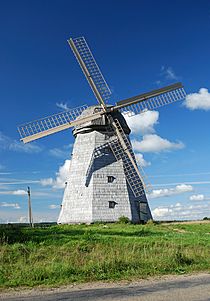
Farming in Lithuania started a very long time ago, around 3,000 to 1,000 years Before Christ. It has been one of the most important jobs in Lithuania for many centuries.
In 2016, Lithuania produced agricultural goods worth 2.29 billion euros. Cereal crops were the largest part of this, with 5,709.7 tons. Other important crops included sugar beets (933.9 tons), rapeseed (392.5 tons), and potatoes (340.2 tons).
Lithuania exported agricultural and food products worth 4,385.2 million euros. Of these, products worth 3,165.2 million euros were made in Lithuania. These exports made up 19.4% of all goods exported from the country.
Organic farming is becoming more popular in Lithuania. A public group called Ekoagros gives special status to organic farmers and producers. In 2016, there were 2,539 such farms. They covered an area of 225,541.78 hectares. Of this land, 43.13% was used for cereals. Perennial grasses covered 31.22%, leguminous crops 13.9%, and other crops 11.75%.
Tourism in Lithuania
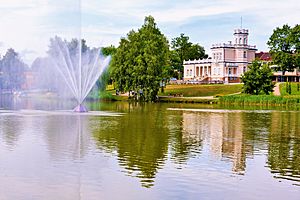
In 2016, 1.49 million tourists from other countries visited Lithuania. They stayed at least one night in the country. Most tourists came from Germany (174,800), Belarus (171,900), and Russia (150,600). Many also came from Poland (148,400), Latvia (134,400), Ukraine (84,000), and the UK (58,200).
People of Lithuania
About 80% of the people in Lithuania are Lithuanians. There are also several large groups of people from other countries:
- The Poles make up 6.3% of the population. They mostly live in Vilnius County. This area was once controlled by Poland in 1920.
- The Russians make up 5.1% of the population. Many live in Vilnius County and Utena County. Some worked at the Ignalina nuclear plant.
- The Belarusians make up 1.1% of the population. Most of them live in Vilnius County.
Lithuanian is spoken by 82% of the people. It is the only official language. Polish is mainly used in Vilnius County. Polish politicians are elected there to represent the Polish minority. However, official documents and street names must be in Lithuanian.
The biggest cities are Vilnius, with 542,287 people. Next is Kaunas, with 358,107 people. Klaipėda has 185,899 people.
Largest Cities in Lithuania
| City | Region | Population | Density* (/km²) | Area (km²) |
|---|---|---|---|---|
| East | 544,206 | 1,354 | 401 | |
| Middle | 355,586 | 2,281 | 157 | |
| West | 184,657 | 1,926 | 98 | |
| North | 127,059 | 1,605 | 81 | |
| North | 113,653 | 2,236 | 52 | |
| South | 68,304 | 1,747 | 40 | |
| South | 47,010 | 2,271 | 21 | |
| North | 40,572 | 2,956 | 14 | |
| Middle | 34,446 | n/d | n/d | |
| East | 32,572 | 2,191 | 15,1 | |
| Middle | 31,055 | n/d | 44 |
Education in Lithuania
Education in Lithuania starts with nursery schools and kindergartens. These are not required. Children begin primary school at age 7. Primary school programs last for 4 years. After that, students go to secondary school, from 5th to 10th grade.
After finishing 8th or 10th grade, students can choose. They can continue learning at high school. Or they can choose courses at a vocational college. Students who finish high school can go to colleges and universities. Higher education is free for students with good grades (an annual average of 8 or higher). Others need to pay for their studies.
The main higher education schools are universities and colleges. The most important universities are:
- Vilnius university (the oldest university in northeastern Europe, started in 1579).
- University of Vytautas the Great, in Kaunas.
- The University of Technology of Gediminas, in Vilnius.
- The Klaipėda University.
Culture of Lithuania
Lithuanian Food
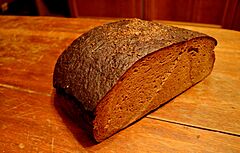
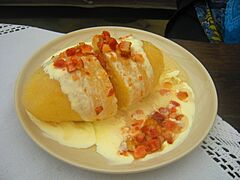
Lithuanian food uses products that grow well in its cool, moist northern climate. These include barley, potatoes, rye, beets, greens, berries, and mushrooms. Dairy products are also a special part of their food. Fish dishes are very popular near the coast.
Lithuanian food is similar to Scandinavian cuisine because they share a similar climate. However, Lithuanian cuisine has its own unique features. These developed from many influences over the country's long history.
Dairy products are very important in traditional Lithuanian food. These include white cottage cheese (varškės sūris), curd (varškė), and sour milk (rūgpienis). Other dairy items are sour cream (grietinė), butter (sviestas), and sour cream butter kastinis. Traditional meat products are often seasoned, aged, and smoked. Examples are smoked sausages (dešros), lard (lašiniai), skilandis, and smoked ham (kumpis).
Soups (sriubos) are also common. These include boletus soup (baravykų sriuba), cabbage soup (kopūstų sriuba), and cold-beet soup (šaltibarščiai). Various kinds of porridges (košės) are part of daily meals. Freshwater fish, herring, wild berries, mushrooms, and honey are still very popular today.
One of the oldest and most basic Lithuanian foods is rye bread. Rye bread is eaten every day for breakfast, lunch, and dinner. Bread was very important in family traditions and farming ceremonies.
Lithuanians share many dishes and drinks with other nations that were once part of the Grand Duchy of Lithuania. German traditions also influenced Lithuanian food. They brought pork and potato dishes, like potato pudding (kugelis) and potato sausages (vėdarai). The fancy tree cake called Šakotis also came from German influence. The kibinai are popular in Lithuania and come from Eastern (Karaite) cuisine. Lithuanian noblemen often hired French chefs, so French cuisine also influenced their cooking.
The Balts have used mead (midus) for thousands of years. Beer (alus) is the most common alcoholic drink. Lithuania has a long history of making farmhouse beer. It was first mentioned in records from the 11th century. Beer was brewed for old Baltic celebrations and rituals. Farmhouse brewing continued in Lithuania more than anywhere else. Over time, Lithuanians developed a commercial brewing culture from these unique traditions. In 2015, Lithuania was among the top 5 countries in Europe for beer drinking per person. It has 75 active breweries, with 32 of them being small microbreweries. The microbrewery scene has grown, with many bars in Vilnius and other cities focusing on these beers.
Eight Lithuanian restaurants are listed in the White Guide Baltic Top 30. The local guide "30 geriausių restoranų" lists the best restaurants in the country. Lithuanian restaurants will also appear in the Michelin Guide starting June 13, 2024.
Public Holidays and Celebrations
Lithuania has two National days due to its long history. The first is Statehood Day on July 6. This day marks the founding of the medieval Kingdom of Lithuania by Mindaugas in 1253. The creation of the modern Lithuanian state is celebrated on February 16. This is Lithuanian State Reestablishment Day. On this day in 1918, Lithuania declared its independence from Russia and Germany.
Joninės (also known as Rasos) is a public holiday with old pagan roots. It celebrates the summer solstice. As of 2018, Lithuania has 13 public holidays, which means a day off from work or school.
Kaziuko mugė is an annual fair held since the early 17th century. It celebrates the anniversary of Saint Casimir's death. Thousands of visitors and many craftspeople attend. Other important festivals include the Vilnius International Film Festival, Kauno Miesto Diena, Klaipėda Sea Festival, Mados infekcija, Vilnius Book Fair, Vilnius Marathon, Devilstone Open Air, and Great Žemaičių Kalvarija Festival.
Sports in Lithuania
Basketball is the most popular and national sport of Lithuania. The Lithuania men's national basketball team has won the EuroBasket three times (in 1937, 1939, and 2003). They have also won 8 other medals in Eurobasket, the World Championships, and the Olympic Games. In 2014, 76% of the country's people watched the men's national team games live. Lithuania hosted the Eurobasket in 1939 and 2011. The famous Lithuanian basketball team BC Žalgiris, from Kaunas, won the European basketball league Euroleague in 1999. Lithuania has produced many NBA players. These include Naismith Memorial Basketball Hall of Fame members Arvydas Sabonis and Šarūnas Marčiulionis. Current NBA players include Jonas Valančiūnas and Domantas Sabonis.
Lithuania has won a total of 26 medals at the Olympic Games. This includes 6 gold medals in athletics, modern pentathlon, shooting, and swimming. Other Lithuanians won Olympic medals while representing the Soviet Union. Discus thrower Virgilijus Alekna is the most successful Olympic athlete from independent Lithuania. He won gold medals in the 2000 Sydney and 2004 Athens games. He also won a bronze in the 2008 Summer Olympics and many World Championship medals. More recently, 15-year-old swimmer Rūta Meilutytė won a gold medal at the 2012 Summer Olympics in London. This made swimming much more popular in Lithuania.
Lithuania hosted the 2021 FIFA Futsal World Cup. This was the first time Lithuania had hosted a FIFA tournament.
Few Lithuanian athletes have found success in winter sports. However, there are several ice rinks and skiing slopes. These include Snow Arena, which is the first indoor ski slope in the Baltics. In 2018, the Lithuania men's national ice hockey team won gold medals at the 2018 IIHF World Championship Division I.
Related Pages
Images for kids
-
Baltic amber was once a valuable trade resource. It was transported from the region of modern-day Lithuania to the Roman Empire and Egypt through the Amber Road.
-
Changes in the territory of Lithuania from the 13th to 15th century. At its peak, Lithuania was the largest state in Europe. Lithuania's strength was its toleration of various cultures and religions.
-
Trakai Island Castle, once the home of the Grand Dukes and the capital city of the medieval state.
-
The Battle of Grunwald, with Vytautas the Great in the center.
-
Emilia Plater, sometimes called a Lithuanian Joan of Arc, leading peasant scythemen during the 1831 uprising.
-
Antanas Smetona was the first and last president of Lithuania during the period between the World Wars (1919–1920, 1926–1940).
-
Lituanica flying over New York in 1933. This transatlantic flight was one of the most accurate in aviation history.
-
Soldiers of the Red Army entering Lithuania during the first Soviet occupation in 1940.
-
The White stork is Lithuania's national bird. It has the highest number of storks per area in Europe.
-
The Hill of Crosses near Šiauliai.
-
Vilnius University, one of the oldest universities in the region. It was founded by Stephen Báthory, King of Poland and Grand Duke of Lithuania, in 1579.
-
The first book ever printed in Lithuanian, Catechism of Martynas Mažvydas (1547).
-
The rock band Antis, which used metaphors in their songs to mock the Soviet Union's strict rules, performing at a concert in 1987.
See also
 In Spanish: Lituania para niños
In Spanish: Lituania para niños




